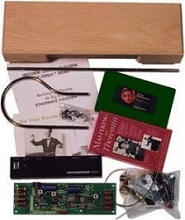It was almost a year ago that I mentioned Augusto Triani on TW's front page for the first time, an Italian who invests much into the revival of the Theremin Cello. He builds wonderful housings for these instruments but first he had not much luck in finding an adequate circuit. There are some videos on YouTube where he or Italian Thereminist Valeria Sturba present different working prototypes but the timbres one could hear was not always convincing. Thus I was asked by Augusto if I could make it better. I thought that I could. But then, things were not as easy as I thought. Building a Theremin with capacitive control and heterodyning is one thing. Building a Theremin Cello with a resistive ribbon controller is another thing. My first attempt went directly into trash before the circuit was really ready. But now I'm proud to publish a positive status update:
"After long months of designing the circuit for the theremincello, rejecting a almost finished version for linearity problems, making simulations in CAD, wiring modules wildly on breadboard, I am now at a point where the circuit is ready and working. Now I am creating the definitive and optimized layout for the circuit board."
The new (purely analogue) circuit will allow to play 5 linear octaves on the ribbon controller, starting with the low C like a classic Cello. A register switch allows to shift either one octave lower or one octave higher which gives a total pitch range of 7 octaves and allows to play most pieces in a comfortable hand position. A rotary knob allows fine tuning of /- 3 halftones. There are 4 timbres among them the player can select: A bright and a soft string timbre, and a bright and a soft woodwind timbre. A special circuit part makes an attempt to make all timbres more "organic", somewhat more rough in the lower register but becoming a little smoother in the middle and high register. A filter switch with 4 positions allows a further gradual smoothing of the very highest frequencies.
Below are already a few sound samples, just 4 octaves out of the 7, with the filter switch set to off. You'll find a surprise among these audio files, because you will hear for the very first time a "pizzicato" emulation from a Theremin Cello, triggered by an extra button.
Augusto's birthday is on March, 31st and I hope to have a working final release of the circuit on a well designed circuit board for him until then.





